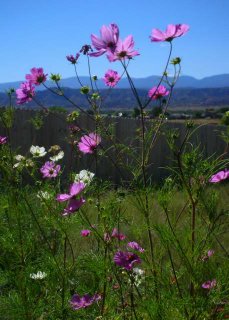 What’s blooming in the area: Lance-leaf yellow brush, datura, purple aster, tahokia daisy, stickleaf, white evening primrose, ragweed, Russian thistle, áñil del muerto, golden hairy aster, goldenrod, bigleaf globeflower, purple mat, only largest roses of Sharon, roses, purple salvia, canna, goat’s head, heavenly blue and wild morning glories, silverlace vine, Maximilian and native sunflowers. Tomatoes and gourds visible, grapes begin to show color, corn leaves turning brown, Virginia creeper turning red. More piles of weeds drying.
What’s blooming in the area: Lance-leaf yellow brush, datura, purple aster, tahokia daisy, stickleaf, white evening primrose, ragweed, Russian thistle, áñil del muerto, golden hairy aster, goldenrod, bigleaf globeflower, purple mat, only largest roses of Sharon, roses, purple salvia, canna, goat’s head, heavenly blue and wild morning glories, silverlace vine, Maximilian and native sunflowers. Tomatoes and gourds visible, grapes begin to show color, corn leaves turning brown, Virginia creeper turning red. More piles of weeds drying.What’s blooming in my garden, looking north: Black-eyed Susan, gloriosa daisy, blanket flower, chocolate flower, perky Sue, fern-leaf yarrow, Mexican hat, yellow cosmos, creeping zinnia, nasturtium, chrysanthemum, miniature roses (Sunrise, Rise and Shine).
Looking east: Garlic chives, California poppy, crackerjack marigold, tall zinnias, winecup, floribunda (Fashion), large flowered soapwort, pink bachelor button, larkspur, thrift, four o’clock, autumn joy sedum, Shirley poppy, sweet alyssum.
Looking south: Small zinnias, crimson rambler morning glory, sensation cosmos, heath aster, sweet peas, hollyhocks, blaze, rugosa and rugosa hybrid (Elisio) roses.
Looking west: Purple coneflower, white phlox (David), frikarti aster, lead plant, catmint, Russian sage, purple ice plant, caryopteris.
Bedding plants: Dalhburg daisies, marigolds, sweet alyssum, snapdragons, petunias, profusion zinnia, nicotiana.
Animal sightings: Bees stay with Russian sage, ants, grasshoppers, dragonfly, cows lowing across the big arroyo, horse, more turkeys, flocks of birds overhead.
Weather: Day’s shorter and mornings colder, stronger afternoon winds with rain mid-week. Ladybells flowers die from cold; spirea and caryopteris leaves begin to change color. Men talk of an early winter.
Weekly update: If you don’t want to look your cosmos in the eye, don’t plant it.
Seed companies keep thinking, if only they could breed a short, well-behaved plant, they would find new buyers.
People either like the flamboyant, simple composite flowers or they don’t. It they love them, they accept their rambunctiousness. If they don’t, housebreaking won’t help.
Still, new varieties appear. PanAmerican developed the shorter, sturdier Sonata for bedding plant suppliers who sell to suburbanites living with neighbors concerned with real estate values and restrictive covenants. Sakata bred Versailles for the European cut flower market. Burpee reminds buyers it’s "very chic." Jung promoted Hinomaru as "elegant," while R. H. Shumway assures growers Sweet Dreams is "exceptionally elegant."
The real thing, the only cosmos, is Sensation, introduced in 1930. The most prominent color in any mix is light lavender pink. The darker rose and white are also sold as Dazzler and Purity.
It’s hard to believe it ‘s been growing here less than 75 years. It’s one of the few annuals found in the village, usually near a fence, wall or walk. It’s currently blooming in three yards, five places on the back road where farmers’ fields survive, and at two houses on the main road. Two have plants more than 6' tall; one has flowers towering over an 8' wall.
The path of Cosmos bipinnatus from Mexico to this Spanish-speaking valley wasn’t the trade route from Zacadecas, but the byways of European fashion. It’s found at low to middling altitudes in the Valley of Mexico where its called mirasol, and farther south in Puebla, Michoacán, Nayarit and Hidalgo. It needs heat to germinate, but long nights to bloom.
The bright flowers captivated nineteenth century English gardeners who grew hundreds in hot houses, then set them in beds that imitated Persian carpet patterns. According to Penelope Hobhouse, they were part of a Mexican plant craze that included zinnias and dahlias.
Greenhouses circumvented the limits of long nights, but nothing could help common gardeners or nurseries hoping to sell to them. In 1917, Robert McCurdy complained that his season was too short for cosmos "which is generally coming into its own about the time of the first frosts." A contemporary rued, "In the Northern States the superior variety, Lady Lennox, seldom blooms."
Sensation changed everything. The tetraploid was bred for longer days, and might bloom by the end of July. The colors are brilliant, the flowers big. It naturalizes despite poor soil, drought, high winds and hard rain.
I’ve never found a good place for cosmos. It’s found places it likes, always in a bed reserved for something else. So we battle - I remove its seedlings from where it wants to grow and it refuses to grow where I want it.
The seeds I planted in mid-May along the back porch have been blooming since mid-July, but languish about a foot high. The leftover seed I threw along my new fence in mid-June started blooming a month later. They’re taller than the May sown plants, so maybe they’ll come back.
For now, the tallest plants are volunteers I missed when I was weeding earlier this year. They track the sun, but it doesn’t matter the flowers turn their backs on me when the sun filters through the petals. I can’t imagine them in a carpet bed. They’re much too independent.
Notes:
Hobhouse, Penelope. Gardening Through the Ages, 1992.
McCurdy, Robert M. The Book of Garden Flowers, copyright 1917, published 1932.
Unidentified comments on cosmos reproduced at backyardgardener.com.
No comments:
Post a Comment